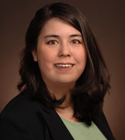
Opening doors to discoveries about human cells
Posted: July 09, 2010
Deeper insights into how human body cells work and how they react to pharmaceuticals are essential to advances in health practices and medical treatments.
ASU’s Jennifer Blain Christen is earning recognition for her work to improve cell research. For years she has helped develop and improve on circuitry systems that maintain the health of cell samples outside the body so that scientists and biomedical engineers can study them more directly.
Blain Christen is an assistant professor in the School of Electrical, Computer and Energy Engineering, one of ASU’s Ira A. Fulton Schools of Engineering.
She recently gave a presentation on her work at the International Symposium on Circuits and Systems, which draws hundreds of leading experts in the field.
Blain Christen’s report on her research also recently won the 2010 Best Paper Award from the Institute of Electrical and Electronics Engineers (IEEE) Circuits and Systems Society.
Her article in the IEEE Transactions on Biomedical Circuits and Systems was recognized as the best published in the journal over the past three years.
It describes a system that makes it possible to maintain cells in same conditions in which they exist inside the body, enabling more effective research to be performed on them.
For cells to live outside the body, it’s critical to maintain proper temperatures, provide the cells nutrients and oxygen, prevent exposing them to contaminants such as bacteria and protect them from other stresses that could destroy or impair them.
For decades this could be accomplished only by use of an incubator – usually the size of a small refrigerator – to provide a sterile environment.
Blaine Christen’s computer-controlled electronics system enables cells to live and thrive outside of such an incubator.
This gives researchers the flexibility to more easily transport cell samples so they can be examined more directly using microscopes, sophisticated electronic measuring instruments and imaging devices – without disrupting the conditions the cells need to survive.
“This enables you to consistently do real-time measurements that give you a fuller picture of what is really going on inside cells,” she explains.
“The system offers a big benefit in heart research and stem-cell research and the development of new pharmaceuticals,” she says.
The flexibility and small size makes it possible to reduce the cost of research and allows researchers to perform several experiments simultaneously in compact work spaces.
Among the technical achievements of the system is the network of tiny valves that act as channels to feed fluids to cells.
“That was a difficult part,” Blain Christen says, “trying to put fluids on top of a computer chip and keeping the liquid from shorting out the circuits.”
At the same time, the fluids had to be carefully controlled so that the constant delivery of liquid nutrients to the cells would not put an amount of pressure on the cells that would damage them.
In addition, a customized gas-permeable material had to be developed that would carefully control the levels of oxygen and carbon dioxide moving to and from cells, providing them the proper mix to sustain themselves.
The easily portable incubation component of the system is hard-wired to the computer/sensor component. Blain Christen says one of the next advances would be to make the system wireless – allowing it to be used even outside conventional laboratories.
Her research, begun when she was a doctoral student at Johns Hopkins University, has earned support from the National Science Foundation.




































